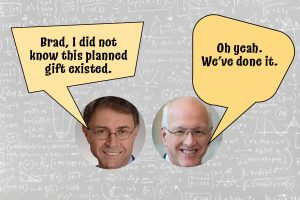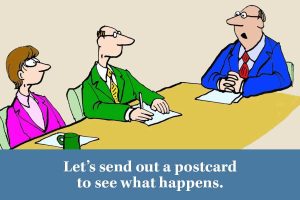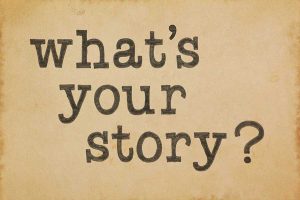
Pigeon Poop. Lear Jets. Planned Giving Newsletters. Direct Mail. And More …
A direct mail campaign that’s not so vanilla. Only in the for-profit world. Would you have had the stomach for it?
Home » Archives for Viken Mikaelian » Page 29

A direct mail campaign that’s not so vanilla. Only in the for-profit world. Would you have had the stomach for it?

A donor can donate a house, get a deduction, live there for life, and receive an annuity from the donation for life. Hmm … does not sound right.

I am amused when a client hires us and then tells us what to do. My favorite inquiry is, “We’d like to send out a planned giving postcard and see if something will happen.”

Remember when news broke that Tiger Woods was cheating — not at golf, but on his wife? The media jumped all over the story.

Are you nurturing your donors? One way to do it is by asking them to tell their story. People like to talk about themselves. It’s natural.

Some people in our industry have made planned giving so moribund that they can put a cat on speed to sleep. Vendors included.

Are you relying on dumb ways to seek donations? A few years ago, a darkly humorous Australian public service ad to promote railway safety went viral. Called “Dumb Ways to Die,” the campaign was set to a catchy song with lyrics including, Set fire to your hair. Poke a stick at a grizzly bear. Eat medicine that’s out of date. Use your private parts as Piranha bait. I have to admit, it was catchy enough (definitely not vanilla marketing!) to get my toes tapping — and it made me think, “there’s some pretty dumb ways to ask for donations, too.” And so, without further ado, I present, Dumb Ways to Seek Donations: 1) Approaching a prospect for an ask without research. Your chances of turning a prospect into a donor increase exponentially when you have a little background info. What causes are they passionate about? Do they have kids? Did they play a sport in school? Who are their friends? Political affiliation? Ask questions. Use Google. Check out LinkedIn. Do your research first! 2 ) Boring them with minutiae. Trust me, donors don’t care about the little details. Try explaining the inner workings of a Charitable Lead Trust and you run the risk of putting your prospect to sleep. And that’s truly one of the dumb ways to seek donations. Sell the sizzle, not the steak. Focus on the benefits — first to the donor, and then to your nonprofit. 3) Shouting “We need money” every four months. People get tired of needy people and needy organizations. It makes them think you don’t know how to manage your budget — and that is how you lose trust. Once you’ve lost trust, you’ve lost the prospect. (Hint: This is where planned gifts come in. They make you look legitimate.) 4) Relying only on a digital campaign. We’re inundated with emails and ads. No one reads all the email in their inbox. If you want to cut through the noise, be sure to employ healthy print marketing. I read that the Dumb Ways to Die characters were so popular they were featured in a marketing campaign for insurance. The tag line was, “the dumbest way to die is without life insurance.” I’d like to add my own take: How about you? What are your favorite dumb ways to give? Comment below or send me an email! Categories: Giving, Major Gifts, Planned Giving Marketing, Marketing Planned Giving

Too busy? Or are you placing Planned Giving on the back burner, again? So many fundraisers make excuses, claiming they’ve placed planned giving on the back-burner because of tight budgets, smaller staffs and not enough time. Bull. There’s an underlying reason that none of us wants to acknowledge: Four years ago we asked fundraisers whether they believed planned giving is “where the money’s at.” A whopping 74% in the survey answered “yes.” But on the very next question, “Where do you spend your time?” a large number (82%) answered “raising cash gifts.” So if they know the correct answer, then why do they consistently place planned giving on the back burner? Because most fundraisers attend to the urgent, not to the important. An analogy can be made here between getting a toothache and visiting the dentist. If we never attend to the important (regularly visiting the dentist) one day we’ll have to attend to the urgent (a toothache that requires a root canal to repair). The same goes for retirement planning. If you’ve never proactively built your retirement savings (endowment), you’ll have to reactively work after you’re 70 just to make ends meet (like chasing and raising annual gifts). Hopefully not at Walmart. If fundraisers never attend to the important task of building a pipeline of planned gifts to provide a stream of long-term support, they will, year after year, waste time on the urgent task of picking up every $100 gift they can find simply to meet their quotas and keep their nonprofit afloat. And, year after year, they’re missing the fact that those consistent $100 givers make the perfect planned giving prospects. Considering the average bequest is over $68,000… I will stop right here and just say… it’s a no-brainer. Get proactive. Attend to the important, not the urgent. It’s all about your future. PS: Here are 21 tips on launching a planned giving program inexpensively. And here are 10 tips and strategies on marketing your program. PPS: Use this interactive assessment tool to see how ready you are for planned giving. And use this one to determine just where your board is at. Categories: Giving, Planned Giving Marketing, Relationships

Most “experts” place the practice as having been birthed in the 1970s — or maybe as far back as the ’40s. So it’s safe to say the first planned gift must have been made sometime in those decades. Right?

“It’s never government, the economy, or tax laws that are our enemy. It’s ourselves.”— A CEO of a healthcare foundation, remaining anonymous.